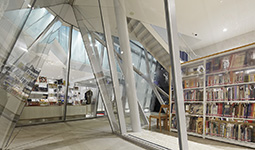Home > Highlighting JAPAN > Highlighting Japan September 2019 > Celebrating Diversity in Culture
Highlighting JAPAN


Hokusai Comes Home
Prints and drawings by the world-famous artist Katsushika Hokusai have found a new home at the Sumida Hokusai Museum in the heart of the neighborhood where Hokusai was born and lived.
Katsushika Hokusai (1760–1849) is an artist most famous for his ukiyo-e woodblock print series Thirty-six Views of Mount Fuji, which includes Under the Wave off Kanagawa, known internationally as The Great Wave, as well as for his bijin-ga, paintings of elegant, beautiful women. Many of Hokusai’s works had a profound influence not only on painting in Japan but also on European and other artists overseas. Hokusai was the only Japanese person to be included in “The 100 Most Important Events and People of the Past 1,000 Years” in The Life Millennium, published in 1998.
The Sumida Hokusai Museum is located in present-day Sumida City, Tokyo, close to the spot where Hokusai was born. The museum is located a short walk from Ryogoku Station, which is also the closest station to the Ryogoku Kokugikan sumo stadium and Edo-Tokyo Museum.
Deputy Director Chiaki Mizukami says, “Hokusai was born in [present-day] Sumida and spent almost his entire life here, leaving many superb works of art. In honor of this outstanding artist whom the local citizens regard with great pride, Sumida City opened the museum in 2016 as a base to invigorate the local community and contribute to the region’s industry and tourism.”
As well as the works collected by Sumida City, the museum houses two bodies of work from the collections of individuals. One is that of the late Hokusai researcher and collector of Hokusai works Peter Morse. The other is the collection of valuable resources gathered by leading ukiyo-e researcher Muneshige Narasaki. These collections are incorporated into special exhibitions with diverse and unique themes.
Curator Yoko Hasegawa has the following to say about the appeal of Hokusai’s works.
“Hokusai left many works during his seventy years of creative activity, but the style is so varied that at first glance it’s hard to believe that they are the work of the same artist. I think the secret of his popularity is his multifaceted appeal. For example, people who know his nishiki-e [multi-colored woodblock prints] then become fascinated by his nikuhitsuga [hand-drawn paintings].”
From September 10th through November 4th, 2019, the special exhibition Hokusai Masterpieces from the Mogi-Honke Museum of Art will be held to commemorate the 170th anniversary of the death of Katsushika Hokusai. The exhibition will showcase 116 of Hokusai’s works, including iconic series such as Thirty-six Views of Mount Fuji and Remarkable Views of Bridges in Various Provinces, as well as works such as the complete Sketches by Hokusai (Hokusai Manga) and One Hundred Views of Mount Fuji. The Mogi-Honke Museum of Art houses a large collection of ukiyo-e masterpieces, and this is the first time that these Hokusai works will be brought together in a single exhibition.
In addition to ukiyo-e, the museum has on permanent exhibition a life-size model of Hokusai at work in his atelier, based on a sketch by one of his students. The exhibit shows Hokusai aged around 84 at work on the floor next to his daughter with whom he lived. There is also a section where visitors can appreciate nishiki-e on a high-definition monitor as they watch video footage explaining how the works are created.
If you visit The Sumida Hokusai Museum, be sure to pay attention to the building itself. The structure was designed by architect Kazuyo Sejima, winner of the Pritzker Prize, known as the Nobel Prize for architects.
“The exterior walls of the structure are made from aluminum panels that have a slightly mirrored surface, allowing the building to blend into the surrounding landscape. Most visitors take photographs of the building,” says Deputy Director Mizukami.
In the future, Mizukami says that he would like to increase the number of visitors from overseas and expand Hokusai’s global appeal.
“Currently, we are preparing brochures in six languages, but we will further enhance the range of multilingual resources offered in the museum. We aim to use a variety of methods to strengthen communication with overseas visitors.”
Paintings featuring motifs from Hokusai’s works may be found on lamp posts and public restroom walls along Hokusai-dori running east from Ryogoku Station and passing in front of the Sumida Hokusai Museum. Why not take your time and look at these paintings as you make your way to the museum through the neighborhood where Hokusai lived?
© 2009 Cabinet Office, Government of Japan








